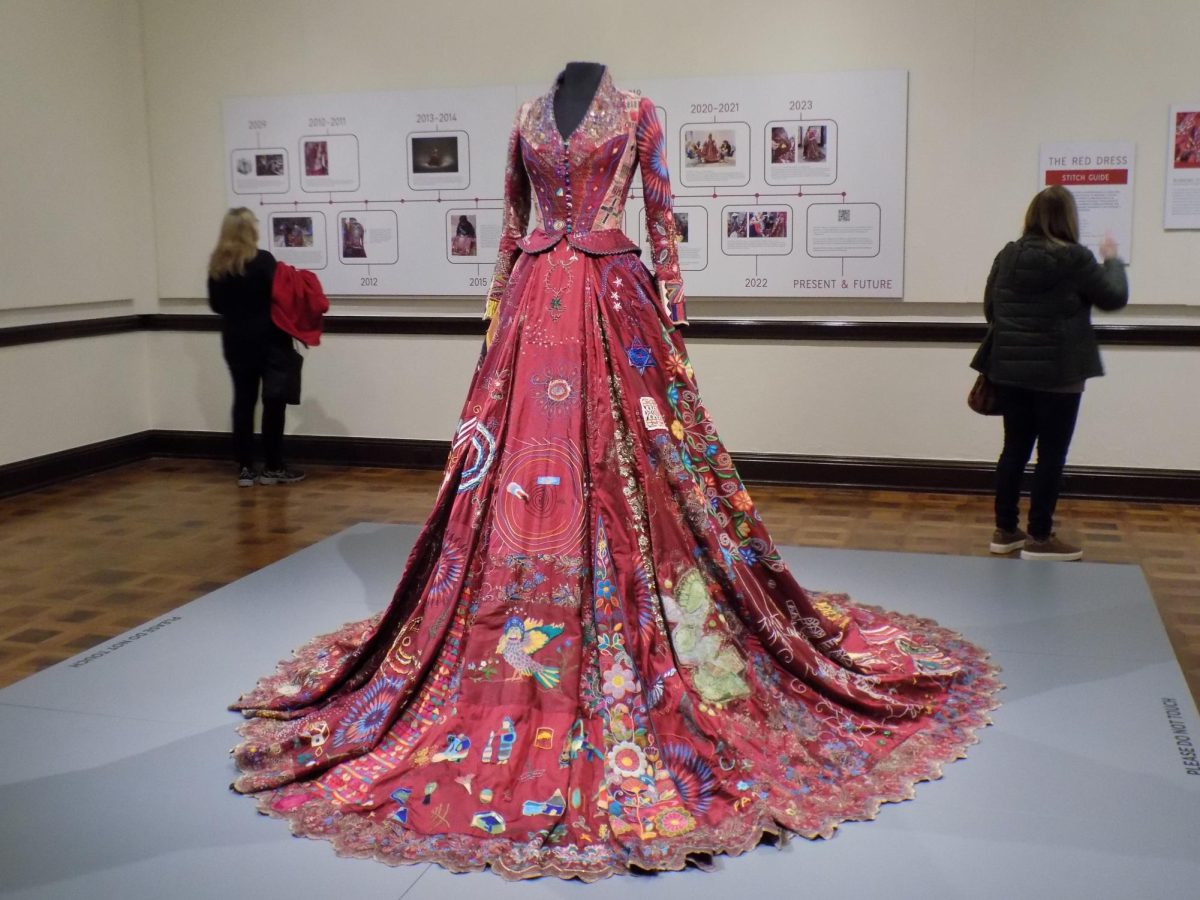Gallery attendees gazed upon the grandeur of the Red Dress exhibition at the Frick Art Museum of Pittsburgh in Point Breeze. The dress is the product of the collaborative embroidery of hundreds of artists around the world. Sitting at the center of the room, it invited viewers to walk around it, exploring its angles and details as a whole.
Its red fabric elegantly flowed onto the pedestal, displaying the intricate works of embroidery. The dress’s measurements fit the average person by design, yet the dress felt larger than life. The creators of the Red Dress intended for its significance to surpass its physical form, conveying a larger global connection.
The Red Dress has journeyed through museums and galleries around the world since 2009, eventually arriving in the United States this year, including a stop in Pittsburgh. The exhibit at the Frick Museum will be on display until Jan. 28, and afterward will travel to the Fuller Craft Museum in Boston.
Kirstie Macleod, the visionary of the project, sketched the idea of the dress on a napkin in a London cafe. It has since transformed into a collective embroidery project by women around the world, involving 380 embroiderers from 51 countries and spanning 14 years. Embroidering the dress offered a medium of expression for the artists to communicate their stories and identity. Many of the women who contributed to the project came from tragic backgrounds of war and poverty. Combining the individual embroidered pieces into a quilt-like construction, the dress symbolizes strength and unity across borders.
One of the contributing embroiderers, Shirley Steenberg, represents her Indigenous heritage and Canadian identity through her stitching. Steenberg identifies as Inuvialuk, an Indigenous group in Canada who live along the coast of the Beaufort Sea. Her embroidery design on the dress took the shape of a medicine wheel, a symbol with a longstanding history among various Native American groups.
Steenberg wrote in her feature on the Red Dress website that, “[The wheel] embodies the Four Directions (north, south, east and west), as well as Father Sky, Mother Earth, and Spirit Tree — all of which symbolize dimensions of health and the cycles of life.” Steenberg’s design also includes Canadian maple leaves and the words “Strong and Free,” quoted from the Canadian national anthem, to represent her country.
Another contributing artist, Ruriko Wyborn, said she represented family and Japanese culture in her design.
“My grandfather had a kimono business, and so my design tried to express the detail, colors and familiar images that are associated with kimono designs in Japan,” Wyborn said.
Several of the messages and symbols in the embroidery pieces focused on social and political advocacy. A group of refugee women from Kosovo called Sister Stitch collaborated to create a design of birds, symbolizing migration, resilience and hope. The women of Sister Stitch fled their homes during the war in Kosovo in the late 1990s. They have since returned to Kosovo and, through Sister Stitch, earn money to help rebuild the lives they were forced to leave behind. Erina Sheholli, the Sister Stitch coordinator, wrote about the message behind their contribution to the dress, which they titled “Birds of Peace.”
“I hope that the message of those birds will spread all over the world. We deserve to live free as birds,” Sheholli wrote.
Contributing embroiderer Nathalie Frost, from Wales, explained her belief in the power of embroidery.
“Craft, especially stitching — so often associated with women — has been overlooked for so long. The Red Dress completely bypasses that notion,” Frost said. “The experience will remain with me and hopefully send messages for future generations who are lucky enough to see and learn about the work.”
The Red Dress exhibition has generated attention not only in the Pittsburgh region, but around the world, museum educator Susanne Wilkinson explained.
“The community has responded very very positively. People are drawn to [The Frick] to see the Red Dress,” Wilkinson said. “We actually just said goodbye to some visitors from Paris.”
Wilkinson says the piece’s overarching message of global unity holds the most significance to her.
“What I like about it is there’s so much detailing in it — and then the story it tells about how people from all these different countries were able to put their thoughts and ideas together and have this magnificent piece that represents the world — and that’s incredible,” Wilkinson said.
Wilkinson explained that even though she has seen the dress countless times, she still finds herself continuing to learn from it and engage with its content in different ways. She encourages others to slow down and pause when viewing the work, allowing time to absorb the details of each message in the embroidery.
“Each time I view the dress, I look at something else because there’s so much to see,” Wilkinson said. “Some messages are subtle and some aren’t — it’s all about looking.”
One Frick attendee, Debra Kirchhof-Glazier, said the dress was enchanting. “There’s no words to adequately describe it … even if you were to take a picture it wouldn’t do justice to it,” Kirchhof-Glazier said. “All of the intensive and emotional artisanship that went into it … I mean, it’s incredible.”



